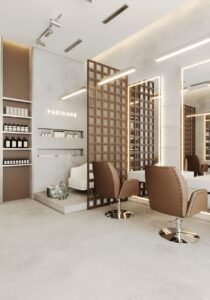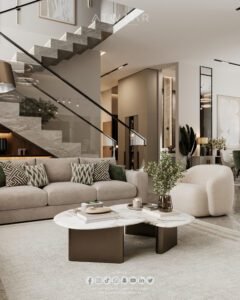Introduction
Interior design is more than just arranging furniture or choosing the right color palette. It’s a multifaceted discipline that blends creativity with technical expertise to enhance the interior spaces of buildings. Whether for residential or commercial purposes, interior design aims to create environments that are both aesthetically pleasing and functional. in the article we will delve into what is interior design?
The Essence of Interior Design
-
Definition and Scope
Interior design is the art and science of improving the interiors of a space to achieve a more aesthetically pleasing and healthier environment for the people using the space. It involves a wide array of tasks, from space planning and conceptual development to site inspections, research, and the execution of the design plan. Interior designers work closely with clients to understand their needs and preferences, translating them into a cohesive design that fits the space perfectly (LuxeDesign) (Greenwood).
Residential vs. Commercial Interior Design
Interior design can be broadly categorized into two main types: residential and commercial. Residential interior design focuses on creating living spaces that reflect the personal style and needs of homeowners. It involves designing everything from single rooms to entire homes, ensuring that the space is comfortable, functional, and tailored to the inhabitants’ lifestyle.
On the other hand, commercial interior design deals with spaces like offices, hotels, restaurants, and retail stores. The primary goal here is to enhance the functionality of the space while also making it attractive and conducive to the business’s objectives. This often requires a deep understanding of branding, customer behavior, and the specific needs of the business (Greenwood).
The Role of an Interior Designer
-
Skills and Expertise
An interior designer’s role is not just about choosing beautiful fabrics and color schemes. It requires a deep understanding of architecture, spatial arrangements, furniture design, and even psychology. Designers need to be adept at problem-solving, as they must navigate the practical limitations of a space, such as lighting, structural integrity, and budget constraints.
In addition to creativity, interior designers must be excellent communicators, as they need to convey their vision to clients, contractors, and other professionals involved in the project. They often collaborate with architects, engineers, and builders to ensure that the design is executed correctly and efficiently (HomeServe Dubai) (LuxeDesign).
-
The Design Process
The interior design process typically begins with an in-depth consultation where the designer gets to know the client’s needs, preferences, and lifestyle. This is followed by the creation of mood boards, sketches, and 3D renderings to help visualize the final outcome. Once the design is approved, the designer oversees the implementation, coordinating with various contractors and suppliers to bring the vision to life (Greenwood).
The Importance of Interior Design
-
Enhancing Quality of Life
A well-designed interior space can significantly improve the quality of life for its occupants. This is achieved by creating environments that are not only beautiful but also functional and comfortable. For instance, good interior design can optimize space in small apartments, making them feel more spacious and organized. In offices, thoughtful design can boost productivity by creating a work environment that is both efficient and inspiring (LuxeDesign).
-
Reflecting Personal Style
Interior design is also a powerful way to express personal style. Whether it’s through the choice of furniture, the color palette, or decorative elements, interior design allows individuals to create spaces that reflect their personality and taste. This is particularly important in residential design, where the goal is to create a home that feels uniquely yours (HomeServe Dubai).
Key Elements of Interior Design
-
Space Planning
One of the most critical aspects of interior design is space planning. This involves determining how the space will be used and arranging furniture and fixtures accordingly. Effective space planning ensures that the room’s layout is functional and that the flow of movement is smooth. It also involves considering factors such as lighting, acoustics, and the needs of the occupants (Greenwood).
-
Color and Lighting
Color and lighting play a significant role in setting the mood and atmosphere of a space. Different colors can evoke different emotions; for instance, blue is often associated with calmness, while red can be stimulating. Lighting, whether natural or artificial, affects how colors are perceived and can dramatically alter the feel of a room. A good interior designer knows how to use color and lighting to enhance the overall design (HomeServe Dubai).
-
Furniture and Materials
Choosing the right furniture and materials is another crucial element of interior design. Furniture must be both aesthetically pleasing and functional, fitting the space and the needs of the occupants. Materials, whether for furniture, flooring, or walls, need to be durable and suitable for the intended use of the space. The choice of materials also affects the room’s acoustics, maintenance requirements, and overall aesthetic (LuxeDesign) (Greenwood).
Trends in Interior Design
-
Sustainability in Design
Sustainability is becoming increasingly important in interior design. Designers are now focusing on using eco-friendly materials, energy-efficient lighting, and sustainable practices to create spaces that are not only beautiful but also environmentally responsible. This trend is particularly prevalent in commercial design, where businesses are looking to reduce their carbon footprint and create greener workspaces (Greenwood).
-
Technology Integration
Technology is also playing a significant role in modern interior design. From smart home systems that control lighting and temperature to 3D visualization tools that allow clients to see how their space will look before any work begins, technology is making the design process more efficient and the results more impressive. This integration of technology is a trend that is expected to continue growing, particularly in high-end residential and commercial design (LuxeDesign).
The Future of Interior Design
-
Evolving Styles and Standards
Interior design is constantly evolving, influenced by changes in technology, culture, and societal needs. Designers must stay informed about the latest trends and developments to remain relevant in this dynamic field. For instance, the rise of remote work has led to an increased demand for home offices, prompting designers to rethink residential spaces to accommodate this new way of living.
Moreover, as the world becomes more interconnected, interior design styles are becoming more global, blending elements from different cultures to create unique and eclectic spaces (Greenwood).
-
The Role of Innovation
Innovation will continue to drive the future of interior design, with new materials, technologies, and approaches shaping how spaces are created and experienced. From virtual reality tools that allow for immersive design experiences to the development of sustainable materials that minimize environmental impact, the future of interior design promises to be exciting and full of possibilities (HomeServe Dubai).
In Conclusion
Interior design is a rich and complex field that combines art, science, and technology to create spaces that enhance the way we live, work, and interact with our environments. Whether in a home, office, or commercial setting, good interior design improves functionality, reflects personal or brand identity, and ultimately enhances the quality of life. As the field continues to evolve, it will undoubtedly continue to play a crucial role in shaping the spaces where we spend our lives.
transform your space into a stunning masterpiece!
At Atwaar Decorations, we specialize in creating bespoke interior designs that reflect your unique style and needs. Whether you’re looking to revamp your home, elevate your commercial space, or enhance your outdoor areas with exquisite landscaping, our team of expert designers is here to bring your vision to life. Plus, our precise technical drawings ensure that every detail is executed to perfection. Don’t wait—contact Atwaar Decorations today and let us create the interior of your dreams in Dubai!






